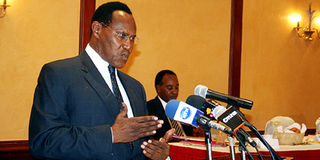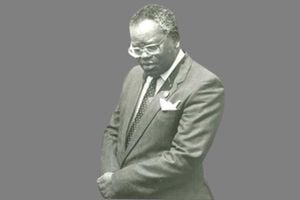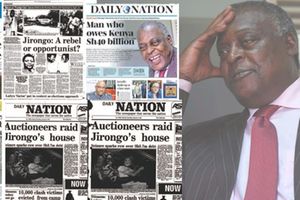
Minister of State for Provincial Administration and Internal Security Prof, George Saitoti.
Vice-President George Saitoti was an introvert—and that is an understatement. From the moment he was appointed to replace Dr Josephat Karanja, a quiet tension clung to him like a second skin. Saitoti seemed perpetually on edge. He looked restless, walked briskly and always watched his back. The weight of the office seemed to weigh down his every move.
And then, on the afternoon of February 13, 1990, the inevitable caught up with him. Assassins closed in and Saitoti, Kenya’s sixth VP and Minister for Finance, was poisoned. His paranoia was now justified.
The previous night, Foreign Minister Robert Ouko, had been picked up from his Koru home and killed. By the time Saitoti was poisoned, information was filtering in that the minister was “missing”.
That fateful day, as was his routine, Saitoti, along with a select few trusted associates, visited his favoured spot, a secluded Indian restaurant at the Muthaiga Shopping Centre in Nairobi. It was the one place where he felt truly secure, drawn in by both the comforting atmosphere and his fondness for Indian cuisine. Had he known of his colleague’s disappearance, he may have cancelled the lunch. But Saitoti lived like a hermit. Not one to court political mingling, he preferred the isolation that came with his introverted, guarded nature.
Close-knit group
It was this close-knit group, including the ever-present Inspector Joshua Tonkei and personal assistant Michael Tanju, that rushed Saitoti to The Nairobi Hospital. His condition was dire, and he was immediately admitted to the intensive care unit under tight security. The nation was already gripped with tension over Ouko’s disappearance, and news of Saitoti’s poisoning would have only fuelled the unfolding drama.
Fearing for his safety, his family and close friends decided to move him home, converting a room into a makeshift recovery ward. Only for blood transfusions was he taken back to the hospital, as doctors worked relentlessly to rid him of the poison.
Even after he recovered, Saitoti was forced to deny “media claims” that he had been poisoned. It was only after President Daniel Moi, some years later, revealed that his VP had been poisoned, that Saitoti confirmed the incident.
Despite his paranoia, Saitoti was a master schemer, corrupt to the core and deeply enmeshed in a web of intricate deals where deceit and death intertwined. Behind his cautious demeanour lay a mind that thrived on manipulation, orchestrating complex transactions with a calculating precision. A professor of mathematics, he was not merely a player but a central figure in a dangerous game, where alliances were fragile, and betrayal was always close.
Born to Zacharia Kiarie and Zipporah Gathoni, Saitoti grappled with a complex identity. Originally named George Kinuthia Kiarie, he grew up in Olkeri, Lower Matasia. He later adopted the name Saitoti after undergoing Maasai initiation rites.
Despite this dual heritage, Saitoti rarely spoke either Kikuyu or Maasai in public, navigating a delicate balance between the two cultures while keeping his personal identity closely guarded. Unlike Mwai Kibaki, Jaramogi Oginga Odinga and Josephat Karanja before him, he could not be accused of rallying any community to his side. Yet, as he found out, that was also a source of political insecurity.
Saitoti’s political rise was heavily influenced by the late Stanley Oloitiptip, a formidable Kajiado politician and former World War II surgical dresser who towered over Maasai politics during the Kenyatta era. Under Oloitiptip’s mentorship, Saitoti rose to prominence as one of the most educated figures within the community.
Influential Maasai politicians
In his thirties, he was nominated to the East African Legislative Assembly as an MP, which greatly elevated his social and political profile. His influence only grew from there, with key appointments such as executive chairman of Mumias Sugar and later Kenya Commercial Bank. His eventual nomination to Parliament and appointment as Minister for Finance further cemented his colourful and impressive rise in Kenya’s power circles.
While Saitoti had the strong support of influential Maasai politicians, few knew that his father had been fully assimilated into the Maasai community. This cultural integration enabled Saitoti's family to embrace Maasai customs, with their children, including Saitoti, being raised in accordance with Maasai traditions. As a result, Saitoti’s upbringing was deeply embedded in Maasai culture, which profoundly shaped his political identity and ability to navigate both his Kikuyu heritage and adopted Maasai roots.
At Ololua Primary School, he was known as Kinuthia wa Kiarie. Later, he adopted the name George Saitoti to secure an undergraduate scholarship to Brandeis University. By the time he completed his PhD thesis in 1972, he had evolved into George Kinuthia Kiarie Saitoti. After joining the University of Nairobi’s Department of Mathematics, he became George K. Saitoti, marking the final transition in his identity.
When he entered the government, he became very close to Cabinet minister Nicholas Biwott, another introvert. He entered Parliament shortly after his mentor, Oloitiptip, had been dethroned in the 1983 snap General Election called to clean up the system of perceived Charles Njonjo followers. Although Oloitiptip had won his Kajiado South seat, he was dropped as Minister for Culture and Social Services and his Cabinet position taken by Saitoti. Shortly after, Oloitiptip was jailed and died a hopeless soul in his Rombo village while being attended by a herbalist.
Saitoti’s poisoning came at a time when Moi was under mounting pressure to embrace multi-party democracy. What made the situation particularly intriguing was that Saitoti himself posed no direct threat to the establishment. However, as the Minister for Finance, he found himself entangled in the web of corrupt cartels. These powerful factions held him hostage—he could neither extricate himself from their grip, nor afford to disappoint them.
The Goldenberg scandal defined Saitoti’s legacy at Treasury, and it is widely speculated that it may have contributed to his poisoning. While he was recuperating at home, the mineral export compensation scheme was being plotted by high-ranking officials from the Office of the President and State House.
Whatever Saitoti knew about what later became the Goldenberg scandal remains unclear. As events unfolded, it emerged that the mastermind, Kamlesh Pattni, had been working closely with James Kanyotu, the head of Special Branch. The two had formed Goldenberg International and sought to secure a 35 per cent export compensation rate. Throughout the ensuing court proceedings, Saitoti steadfastly maintained his innocence.
However, Saitoti was neither entirely innocent nor naive. He was entangled in the thuggish networks that operated during the dark days of the Nyayo era.
Saitoti’s life as VP under Moi was hellish. He became a yes-man, never displaying the slightest hint of disloyalty. If he harboured presidential ambitions, he kept them deeply buried. He watched as his friend Mohammed Aslam, chairman of Pan African Bank and the brains behind the Grand Regency Hotel (now Lyco Regency), make the fateful decision to testify before the Ouko Inquiry. Aslam died shortly after, under mysterious circumstances.
Humiliation
The final humiliation of Saitoti occurred on March 18, 2002 as Raila Odinga’s National Development Party (NDP) prepared to merge with Kanu. For years, as Kenya's longest-serving VP Saitoti was widely seen as Moi’s natural successor.
That morning, as he drove from his Lavington home to Kasarani gymnasium, he was confident that he would retain his seat as Kanu’s vice-president. Mr Odinga, too, believed the merger would propel him toward the elusive presidency. Both men were unaware of the dramatic political shifts that had already taken place behind the scenes.
Saitoti, having campaigned hard across Kenya, naively believed that his position as VP would secure him one of Kanu's senior posts. He underestimated the extent of the machinations taking place at State House, where key Rift Valley elites he had once aligned with had conspired against him. Another casualty of this political betrayal was Kanu Secretary-General Joseph Kamotho.
As they approached Kasarani, neither Saitoti nor Kamotho had any inkling of the humiliation awaiting them. Four Kanu vice-president positions had been created to represent various regions: Musalia Mudavadi for Western, Katana Ngala for Coast, Uhuru Kenyatta for Central and Kalonzo Musyoka for Eastern. Raila was to become Kanu’s secretary-general, while Moi retained his role as party president. It was a carefully orchestrated arrangement to balance regional power. Unbeknownst to Saitoti, Moi had already set his sights on grooming Uhuru as his successor, having appointed him chairman of the Kenya Tourism Board and later nominating him to Parliament and the Cabinet in 2001.
Raila, meanwhile, hoped to capitalise on the merger by combining Kanu’s voter base with his own support in Nyanza.
Saitoti’s downfall was exacerbated by his shrinking circle of confidants and his fear of the Kanu power brokers. On that fateful day, as the NDP-Kanu merger ceremony commenced, Saitoti was horrified to find his name missing from the line-up. Multiple sources recount how he confronted Moi, bitterly complaining about his omission. In an uncharacteristic public outburst, Saitoti, usually reserved, was met with Moi's cold rebuke: “Kimya (shut up!), Professor. If your name is not on the list, it is not there.”
It was in that moment that Saitoti realised he had been sidelined in the Kanu succession. He took the microphone and delivered one of the most memorable speeches of his political career.
“I know there are many of you who wanted me to contest, is that not so?” he asked the delegates. “There come (sic) a time when the nation is more important than an individual... but one day I will be proved right.”
That evening, he gathered with a small group of confidants, as was his habit. Saitoti, known to enjoy a glass of cognac, took several shots.
As the Moi succession turned tricky, he was fired on August 30, 2002 to clear the way for Uhuru’s candidacy.
Postscript: On June 10, 2012, Saitoti died in a mysterious helicopter accident. By then he was gunning to replace President Mwai Kibaki.
Tomorrow: Musalia Mudavadi, the stop-gap VP. @Johnkamau1
Read also:









